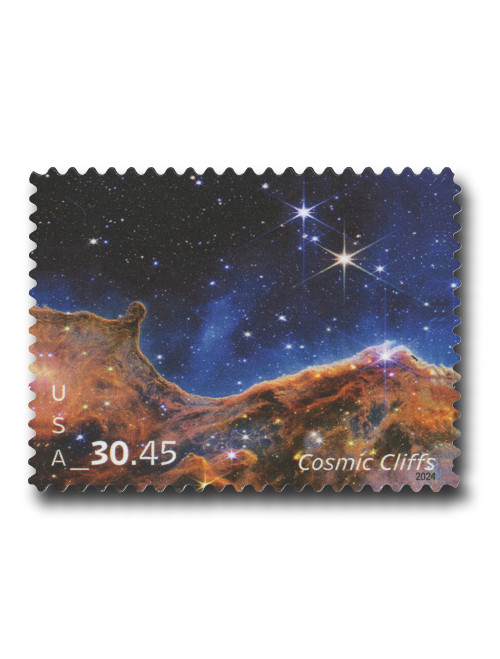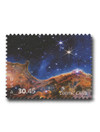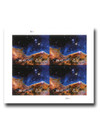
# 5828 - 2024 $30.45 Cosmic Cliffs - Priority Mail Express
US #5828
2024 Cosmic Cliffs – Express Mail
• The first non-American Landmarks Series Express Mail stamp since 2008
• Pictures state-of-the-art image from NASA’s new James Webb Space Telescope
Stamp Category: Definitive
Value: $30.45 Express Mail Rate
First Day of Issue: January 22, 2024
First Day City: Greenbelt, Maryland
Quantity Issued: 600,000
Printed by: Ashton Potter (USA) Ltd.
Printing Method: Offset, Microprint
Format: Panes of 4
Tagging: Nonphosphored Type III, Block Tag Applied
Why the stamp was issued: To cover the Express Mail Rate and celebrate the groundbreaking images of NASA’s James Webb Space Telescope.
About the stamp design: Pictures an image of deep space taken by NASA’s James Webb Space Telescope. According to the USPS, this stamp shows “a digitally colored depiction of the invisible bands of mid-infrared light emitted by the Cosmic Cliffs. Red and yellow flares scattered throughout the cliffs show developing and newly born stars. The orange and brown clouds in the lower third of the image are swirls of dust and gas. Additional stars, in our Milky Way and in distant galaxies, appear in the blue and black regions above and beyond the nebula.” The image for this stamp was supplied in collaboration with NASA (National Aeronautics and Space Administration), ESA (European Space Agency), Canadian Space Agency, and the Space Telescope Institute.
First Day City: There was no First Day of Issue Ceremony, but the First Day of Issue postmark was from Greenbelt, Maryland, the location of NASA’s Goddard Space Flight Center which coordinated the development of the James Webb Space Telescope.
History the stamp represents: In 2024, the USPS issued an Express Mail stamp picturing an image from the James Webb Space Telescope (JWST). It shows a photograph of the structure known as the “Cosmic Cliffs,” located within the deep space Carina Nebula.
Before JWST was launched in 2022, there had been previous observations of the Carina Nebula, but some details were blocked from view. With JWST’s technological advancements, scientists could see through the cosmic dust. They were able to witness some of the earliest stages of star formation as well as a clearer view of the Cosmic Cliffs (so-called for the clouds of gas and dust resembling mountains and valleys). JWST used infrared imaging to capture the greatest degree of detail.
It is believed the Cosmic Cliffs were formed due to extreme ultraviolet radiation and stellar winds from the massive, hot, young stars in the region. As these forces erode the clouds of dust and gas, they form elaborate-looking structures. Before the JWST, ordinary visible light photographs could not capture these details. The space telescope can even capture images of protostellar jets shooting out from some of the young stars. According to NASA, they hope JWST will “address some of the great, open questions of modern astrophysics.”
US #5828
2024 Cosmic Cliffs – Express Mail
• The first non-American Landmarks Series Express Mail stamp since 2008
• Pictures state-of-the-art image from NASA’s new James Webb Space Telescope
Stamp Category: Definitive
Value: $30.45 Express Mail Rate
First Day of Issue: January 22, 2024
First Day City: Greenbelt, Maryland
Quantity Issued: 600,000
Printed by: Ashton Potter (USA) Ltd.
Printing Method: Offset, Microprint
Format: Panes of 4
Tagging: Nonphosphored Type III, Block Tag Applied
Why the stamp was issued: To cover the Express Mail Rate and celebrate the groundbreaking images of NASA’s James Webb Space Telescope.
About the stamp design: Pictures an image of deep space taken by NASA’s James Webb Space Telescope. According to the USPS, this stamp shows “a digitally colored depiction of the invisible bands of mid-infrared light emitted by the Cosmic Cliffs. Red and yellow flares scattered throughout the cliffs show developing and newly born stars. The orange and brown clouds in the lower third of the image are swirls of dust and gas. Additional stars, in our Milky Way and in distant galaxies, appear in the blue and black regions above and beyond the nebula.” The image for this stamp was supplied in collaboration with NASA (National Aeronautics and Space Administration), ESA (European Space Agency), Canadian Space Agency, and the Space Telescope Institute.
First Day City: There was no First Day of Issue Ceremony, but the First Day of Issue postmark was from Greenbelt, Maryland, the location of NASA’s Goddard Space Flight Center which coordinated the development of the James Webb Space Telescope.
History the stamp represents: In 2024, the USPS issued an Express Mail stamp picturing an image from the James Webb Space Telescope (JWST). It shows a photograph of the structure known as the “Cosmic Cliffs,” located within the deep space Carina Nebula.
Before JWST was launched in 2022, there had been previous observations of the Carina Nebula, but some details were blocked from view. With JWST’s technological advancements, scientists could see through the cosmic dust. They were able to witness some of the earliest stages of star formation as well as a clearer view of the Cosmic Cliffs (so-called for the clouds of gas and dust resembling mountains and valleys). JWST used infrared imaging to capture the greatest degree of detail.
It is believed the Cosmic Cliffs were formed due to extreme ultraviolet radiation and stellar winds from the massive, hot, young stars in the region. As these forces erode the clouds of dust and gas, they form elaborate-looking structures. Before the JWST, ordinary visible light photographs could not capture these details. The space telescope can even capture images of protostellar jets shooting out from some of the young stars. According to NASA, they hope JWST will “address some of the great, open questions of modern astrophysics.”














